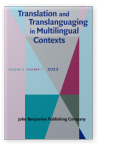Vol. 8:1 (2022) ► pp.1–29
Vol. 8:1 (2022) ► pp.1–29
Audio description and subtitling for the deaf and hard of hearing
Media accessibility in foreign language learning
This paper presents the teaching innovation project AUDIOSUB, which aimed at assessing the didactic potential of audio description (AD) and subtitling for the deaf and hard of hearing (SDH) in foreign language education. Within an online setting, 25 undergraduates of English Studies in a Spanish university worked collaboratively for two months and a half, in groups of five, so as to provide accessibility to complete short films. To that end, they were provided with a number of ad hoc tutorials and guidelines on technical issues related to AD and SDH, the two media accessibility modes used for this proposal. A pre-experiment was designed for data collection: pre- and post- writing and oral production tests, as well as general translation pre- and post- tests, were administered, and quantitative data were exploited using SPSS; pre-and post- questionnaires and observation were also used to triangulate and complement the analysis. The results show evidence of improvement both in written production and in general translation skills thanks to the pedagogical application of media accessibility and point towards a more systematic exploitation of didactic SDH and AD in the foreign language learning context.
Article outline
- 1.Introduction
- 2.Literature review
- 3.Methods and materials
- 4.Research methodology
- 5.Sample description
- 6.Data analysis and results
- 7.Discussion
- 8.Conclusions
- Acknowledgements
-
References
